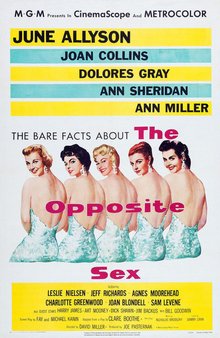Production
Unlike the 1936 play and the 1939 film adaptation, The Opposite Sex includes musical numbers and features male actors who portray the husbands and boyfriends, whose characters were only referred to in the previous film and stage versions. [6] This alters the structure and tone of the base storyline significantly.
Fay Kanin who cowrote the script with her husband Michael said the studio's argument was "you can't play a love scene alone." Michael said the studio "felt the movie audience would somehow be disappointed at not seeing men in it. After all, a man is a fact." [7]
Fay Kanin thought the "manless world" of the play "was a stunt, an artificial trick, but it was accepted. But in a movie, which has the freedom to go out, the device would seem constrained and self conscious." Michael claimed "we only put in men to relieve the strain - and only when they are called for." [7]
The Kanins gave the story a show business background to help justify it being turned into a musical, but "there are no big production numbers," according to Fay Kanin. [7]
Elaine Stewart was promised Joan Collins' role before filming. Grace Kelly was supposed to have June Allyson's role, but she retired from acting before filming. MGM studio head Dore Schary envisioned Esther Williams in Allyson's role. According to her 2000 autobiography The Million Dollar Mermaid, Williams objected to Schary's casting suggestion, resulting in her suspension from the studio. Shortly after, on agent Lew Wasserman's advice, she left Metro after 14 years. [8] Eleanor Parker was cast as Kay Hilliard but replaced by Allyson. [9]
Jo Ann Greer dubbed Allyson's ballad "A Perfect Love".
In November 1955, Joe Pasternak was pursuing Marlene Dietrich and Miriam Hopkins. [10] In December 1955, MGM announced the lead roles would be played by Allyson, Dolores Gray, Ann Miller (as the husband stealer), and Leslie Nielsen with filming to begin January 16, 1956. [11] Jeff Richards was cast as Buck Winston in an effort by Metro-Goldwyn-Mayer to build on his success after starring in Seven Brides For Seven Brothers . [12] In the 1939 version of The Women, actress Lucile Watson was featured in the cast as Mrs. Morehead, the loving, wise, and supportive mother of Norma Shearer's character Mary Haines. For the 1956 version, the role was eliminated, and a new character was created instead - Amanda Penrose, a playwright who served as Kay Hilliard's kind friend confidante. Ann Sheridan was cast in this part.
Barbara Jo Allen had the distinction of being in both the 1939 and 1956 versions—in the first film, she had a small, uncredited part as a receptionist; in the second, she played gossip columnist Dolly DeHaven.
This was Allyson's final film for MGM after having worked at the studio for nearly 15 years.
Critical reception
At the time of the film's release, film critic Bosley Crowther wrote in The New York Times that the film had a "venomous mixture of deadly females vs. deadlier females, sharp dialogue and songs," that "the principals, who keep the catfights going briskly, make it [...] interesting," and "the lush wardrobes, enhanced by excellent color photography, provided for this covey of dames, is enough to drive distaff viewers to distraction." [13] In the Orlando Sentinel , critic Jean Yothers wrote that the film "sparkles with snappy dialogue, a parade of smart fashions and a beauty of a hair-pulling, dress-tearing, name-calling fight" and that "several entertaining subplots keep popping up as do a group of musical numbers," but noted that "it does seem an unfortunate waste of talent to have Dolores Gray around and not singing and Ann Miller around and not dancing." [14]
In the 21st century, a review of the film on AllMovie by Craig Butler reported that "if it's a disappointing and flawed adaptation [of The Women], it's still good fun on its own terms," and noted that it had "a mediocre score with poor and unimaginative lyrics," but that Gray is "a delectable steamroller in her scenes." [15]
According to MGM records, the film earned $1,735,000 in the U.S. and Canada and $1,025,000 in other markets, resulting in a loss of $1,513,000. [1]
This page is based on this
Wikipedia article Text is available under the
CC BY-SA 4.0 license; additional terms may apply.
Images, videos and audio are available under their respective licenses.
